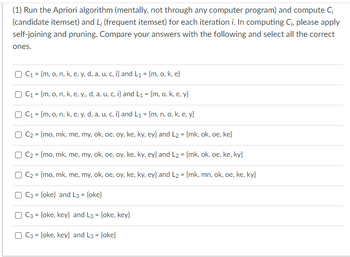
Database System Concepts
7th Edition
ISBN: 9780078022159
Author: Abraham Silberschatz Professor, Henry F. Korth, S. Sudarshan
Publisher: McGraw-Hill Education
expand_more
expand_more
format_list_bulleted
Question

Transcribed Image Text:(1) Run the Apriori algorithm (mentally, not through any computer program) and compute Ci
(candidate itemset) and L; (frequent itemset) for each iteration i. In computing C₁, please apply
self-joining and pruning. Compare your answers with the following and select all the correct
ones.
C₁ = {m, o, n, k, e, y, d, a, u, c, i} and L₁ = {m, o, k, e}
C₁ = {m, o, n, k, e, y,, d, a, u, c, i} and L₁ = {m, o, k, e, y}
C₁ = {m, o, n, k, e, y, d, a, u, c, i} and L₁ = {m, n, o, k, e, y}
C2 = {mo, mk, me, my, ok, oe, oy, ke, ky, ey} and L2 = {mk, ok, oe, ke}
C₂ = {mo, mk, me, my, ok, oe, oy, ke, ky, ey} and L2 = {mk, ok, oe, ke, ky}
C₂ = {mo, mk, me, my, ok, oe, oy, ke, ky, ey} and L2 = {mk, mn, ok, oe, ke, ky}
C3 = {oke} and L3 = {oke}
C3 = {oke, key} and L3 = {oke, key}
C3 = {oke, key} and L3 = {oke}

Transcribed Image Text:The following database has 5 transactions. Let min_sup = 60% and min_conf = 80%.
TID
Items_bought
T100
{m, o, n, k, e, y}
T200
{d, o, n, k, e, y}
T300
{m, a, k, e}
T400
{m, u, c, k, y}
T500
{c, o, k, i, e}
Expert Solution
This question has been solved!
Explore an expertly crafted, step-by-step solution for a thorough understanding of key concepts.
This is a popular solution
Trending nowThis is a popular solution!
Step by stepSolved in 1 steps

Knowledge Booster
Similar questions
- A problem called S reduces to a problem called T if a T solver can be used as a subroutine to solve S. In pseudocode: Solves(...): ... SolveT(...) ... Assuming that this reduction is correct, answer the following questions regarding what the reduction tells us. If we know that an algorithm exists for solving Problem S, what does that tell us about Problem T? [ Select] If we know that an algorithm cannot exist for solving Problem S, what does that tell us about Problem T? [ Select] If we know that an algorithm exists for solving Problem T, what does that tell us about Problem S? [ Select ] [ Select ] An algorithm cannot exist for solving Problem S,r solving Problem T, what does that tell us about Nothing An algorithm exists for solving Problem Sarrow_forwardCan you please solve a and b. The exercise is for a course call computer organizationarrow_forwardGive a recursive definition for the set of all strings of a’s and b’s that begins with an a and ends in a b. Say, S = { ab, aab, abb, aaab, aabb, abbb, abab..} Let S be the set of all strings of a’s and b’s that begins with a and ends in a b. The recursive definition is as follows – Base:... Recursion: If u ∈ S, then... Restriction: There are no elements of S other than those obtained from the base and recursion of S.arrow_forward
- a)Write a recursive definition for the set of odd positive integers. b)Use master theorem to find the solution to the recurrence relation f(n) = 4f(n/2) + 2? ! ,when n = 2" , where k is a positive integer and f(1) = 1.arrow_forward* Axiomatic Proof Prove the following program for integer division (x/y): { x>= 0 ^ y>0 } q := 0; r := x; while y <= r do begin r := r - y; q := q + 1; end { y > r ^ x = r + y * q }arrow_forwardWrite a fraction calculator program that adds, subtracts, multiplies, and di-vides fractions. Your program should check for the division by 0, have and use the following functions (a) reduce - reduces a given fraction.(b) flip - reduces a given fraction and flips the sign if the denominator is negative.(c) add - finds the reduced sum of a pair of given fractions.arrow_forward
- Find the maximum value of the following function F(x)=2x3 , using the genetic algorithm, performing two iterations.arrow_forwardLet ∑={a,b} and T be the set of words in ∑* that have no consecutive a’s (i.e. there cannot be 2 or more a’s in a row). (a) Give a recursive definition for the set T. (b) Use your recursive definition to show that the string “abbaba” is in T. (c) Is your recursive definition uniquely determined? Explain why or why not.arrow_forwardI need the answer as soon as possiblearrow_forward
arrow_back_ios
arrow_forward_ios
Recommended textbooks for you
 Database System ConceptsComputer ScienceISBN:9780078022159Author:Abraham Silberschatz Professor, Henry F. Korth, S. SudarshanPublisher:McGraw-Hill Education
Database System ConceptsComputer ScienceISBN:9780078022159Author:Abraham Silberschatz Professor, Henry F. Korth, S. SudarshanPublisher:McGraw-Hill Education Starting Out with Python (4th Edition)Computer ScienceISBN:9780134444321Author:Tony GaddisPublisher:PEARSON
Starting Out with Python (4th Edition)Computer ScienceISBN:9780134444321Author:Tony GaddisPublisher:PEARSON Digital Fundamentals (11th Edition)Computer ScienceISBN:9780132737968Author:Thomas L. FloydPublisher:PEARSON
Digital Fundamentals (11th Edition)Computer ScienceISBN:9780132737968Author:Thomas L. FloydPublisher:PEARSON C How to Program (8th Edition)Computer ScienceISBN:9780133976892Author:Paul J. Deitel, Harvey DeitelPublisher:PEARSON
C How to Program (8th Edition)Computer ScienceISBN:9780133976892Author:Paul J. Deitel, Harvey DeitelPublisher:PEARSON Database Systems: Design, Implementation, & Manag...Computer ScienceISBN:9781337627900Author:Carlos Coronel, Steven MorrisPublisher:Cengage Learning
Database Systems: Design, Implementation, & Manag...Computer ScienceISBN:9781337627900Author:Carlos Coronel, Steven MorrisPublisher:Cengage Learning Programmable Logic ControllersComputer ScienceISBN:9780073373843Author:Frank D. PetruzellaPublisher:McGraw-Hill Education
Programmable Logic ControllersComputer ScienceISBN:9780073373843Author:Frank D. PetruzellaPublisher:McGraw-Hill Education

Database System Concepts
Computer Science
ISBN:9780078022159
Author:Abraham Silberschatz Professor, Henry F. Korth, S. Sudarshan
Publisher:McGraw-Hill Education

Starting Out with Python (4th Edition)
Computer Science
ISBN:9780134444321
Author:Tony Gaddis
Publisher:PEARSON

Digital Fundamentals (11th Edition)
Computer Science
ISBN:9780132737968
Author:Thomas L. Floyd
Publisher:PEARSON

C How to Program (8th Edition)
Computer Science
ISBN:9780133976892
Author:Paul J. Deitel, Harvey Deitel
Publisher:PEARSON

Database Systems: Design, Implementation, & Manag...
Computer Science
ISBN:9781337627900
Author:Carlos Coronel, Steven Morris
Publisher:Cengage Learning

Programmable Logic Controllers
Computer Science
ISBN:9780073373843
Author:Frank D. Petruzella
Publisher:McGraw-Hill Education